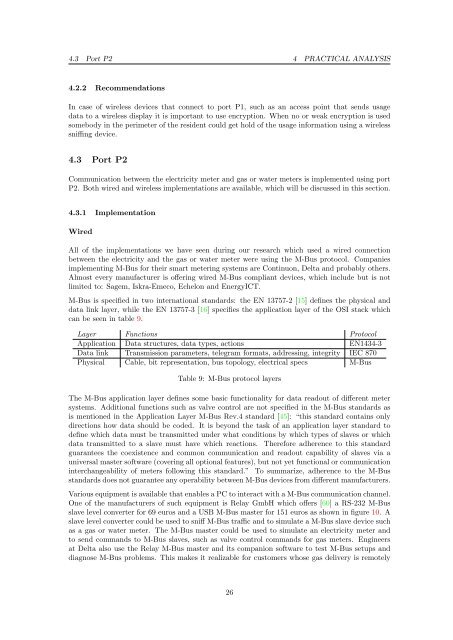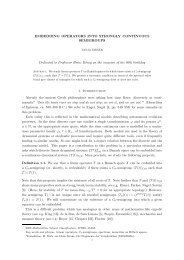Security analysis of Dutch smart metering systems - Multiple Choices
Security analysis of Dutch smart metering systems - Multiple Choices
Security analysis of Dutch smart metering systems - Multiple Choices
Create successful ePaper yourself
Turn your PDF publications into a flip-book with our unique Google optimized e-Paper software.
4.3 Port P2 4 PRACTICAL ANALYSIS<br />
4.2.2 Recommendations<br />
In case <strong>of</strong> wireless devices that connect to port P1, such as an access point that sends usage<br />
data to a wireless display it is important to use encryption. When no or weak encryption is used<br />
somebody in the perimeter <strong>of</strong> the resident could get hold <strong>of</strong> the usage information using a wireless<br />
sniffing device.<br />
4.3 Port P2<br />
Communication between the electricity meter and gas or water meters is implemented using port<br />
P2. Both wired and wireless implementations are available, which will be discussed in this section.<br />
4.3.1 Implementation<br />
Wired<br />
All <strong>of</strong> the implementations we have seen during our research which used a wired connection<br />
between the electricity and the gas or water meter were using the M-Bus protocol. Companies<br />
implementing M-Bus for their <strong>smart</strong> <strong>metering</strong> <strong>systems</strong> are Continuon, Delta and probably others.<br />
Almost every manufacturer is <strong>of</strong>fering wired M-Bus compliant devices, which include but is not<br />
limited to: Sagem, Iskra-Emeco, Echelon and EnergyICT.<br />
M-Bus is specified in two international standards: the EN 13757-2 [15] defines the physical and<br />
data link layer, while the EN 13757-3 [16] specifies the application layer <strong>of</strong> the OSI stack which<br />
can be seen in table 9.<br />
Layer Functions Protocol<br />
Application Data structures, data types, actions EN1434-3<br />
Data link Transmission parameters, telegram formats, addressing, integrity IEC 870<br />
Physical Cable, bit representation, bus topology, electrical specs M-Bus<br />
Table 9: M-Bus protocol layers<br />
The M-Bus application layer defines some basic functionality for data readout <strong>of</strong> different meter<br />
<strong>systems</strong>. Additional functions such as valve control are not specified in the M-Bus standards as<br />
is mentioned in the Application Layer M-Bus Rev.4 standard [45]: “this standard contains only<br />
directions how data should be coded. It is beyond the task <strong>of</strong> an application layer standard to<br />
define which data must be transmitted under what conditions by which types <strong>of</strong> slaves or which<br />
data transmitted to a slave must have which reactions. Therefore adherence to this standard<br />
guarantees the coexistence and common communication and readout capability <strong>of</strong> slaves via a<br />
universal master s<strong>of</strong>tware (covering all optional features), but not yet functional or communication<br />
interchangeability <strong>of</strong> meters following this standard.” To summarize, adherence to the M-Bus<br />
standards does not guarantee any operability between M-Bus devices from different manufacturers.<br />
Various equipment is available that enables a PC to interact with a M-Bus communication channel.<br />
One <strong>of</strong> the manufacturers <strong>of</strong> such equipment is Relay GmbH which <strong>of</strong>fers [60] a RS-232 M-Bus<br />
slave level converter for 69 euros and a USB M-Bus master for 151 euros as shown in figure 10. A<br />
slave level converter could be used to sniff M-Bus traffic and to simulate a M-Bus slave device such<br />
as a gas or water meter. The M-Bus master could be used to simulate an electricity meter and<br />
to send commands to M-Bus slaves, such as valve control commands for gas meters. Engineers<br />
at Delta also use the Relay M-Bus master and its companion s<strong>of</strong>tware to test M-Bus setups and<br />
diagnose M-Bus problems. This makes it realizable for customers whose gas delivery is remotely<br />
26

















